Changing Nature of Working Practices
VerifiedAdded on 2023/01/10
|8
|2556
|66
AI Summary
This report discusses the transition in the working practices of the UK over time, from the labor-intensive techniques of the industrial revolution to the adoption of technology-intensive approaches. It explores the impact of these changes on work conditions and the role of socio-economic factors. The report also highlights the future trends of automation and innovation in the workplace.
Contribute Materials
Your contribution can guide someone’s learning journey. Share your
documents today.
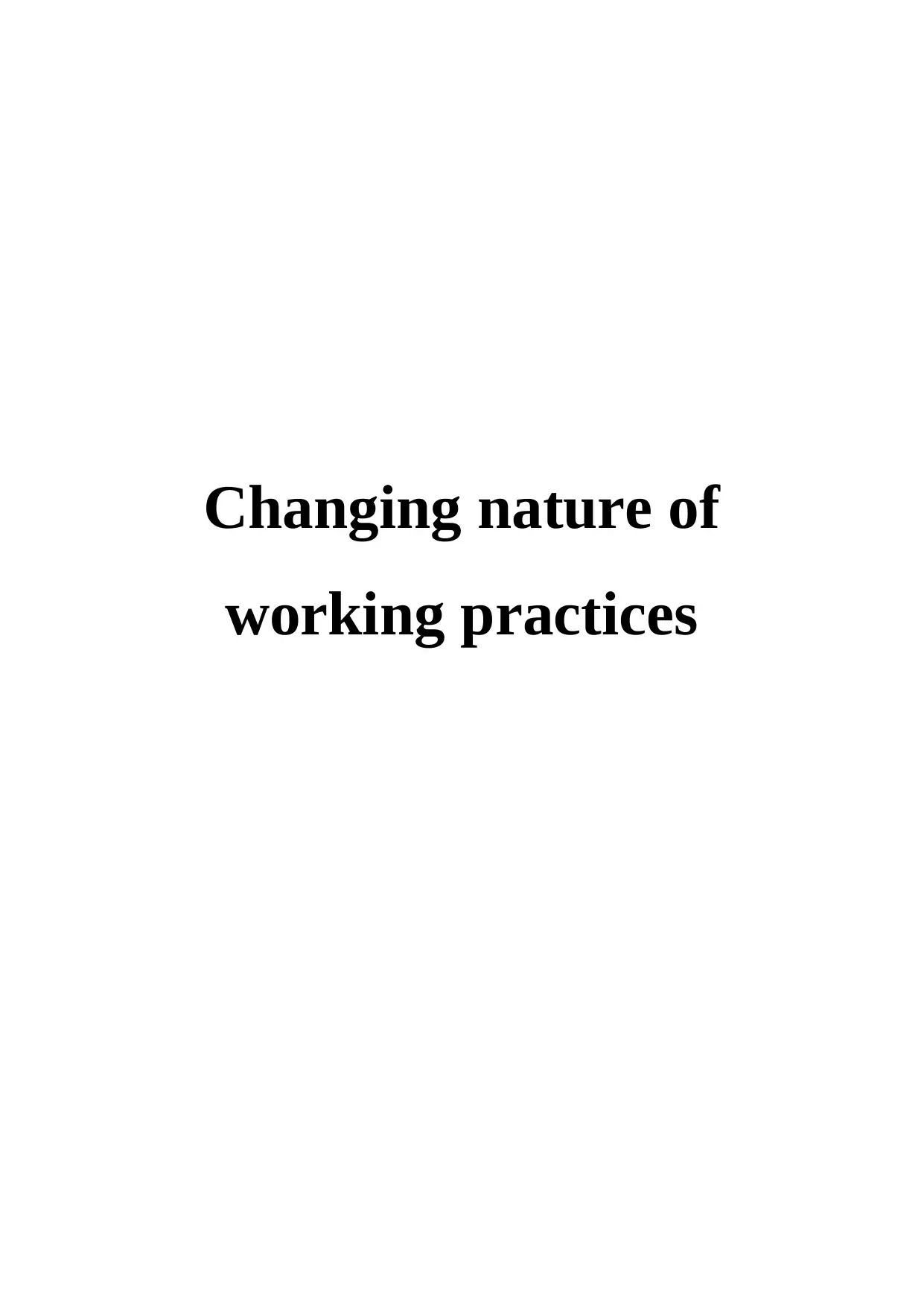
Changing nature of
working practices
working practices
Secure Best Marks with AI Grader
Need help grading? Try our AI Grader for instant feedback on your assignments.
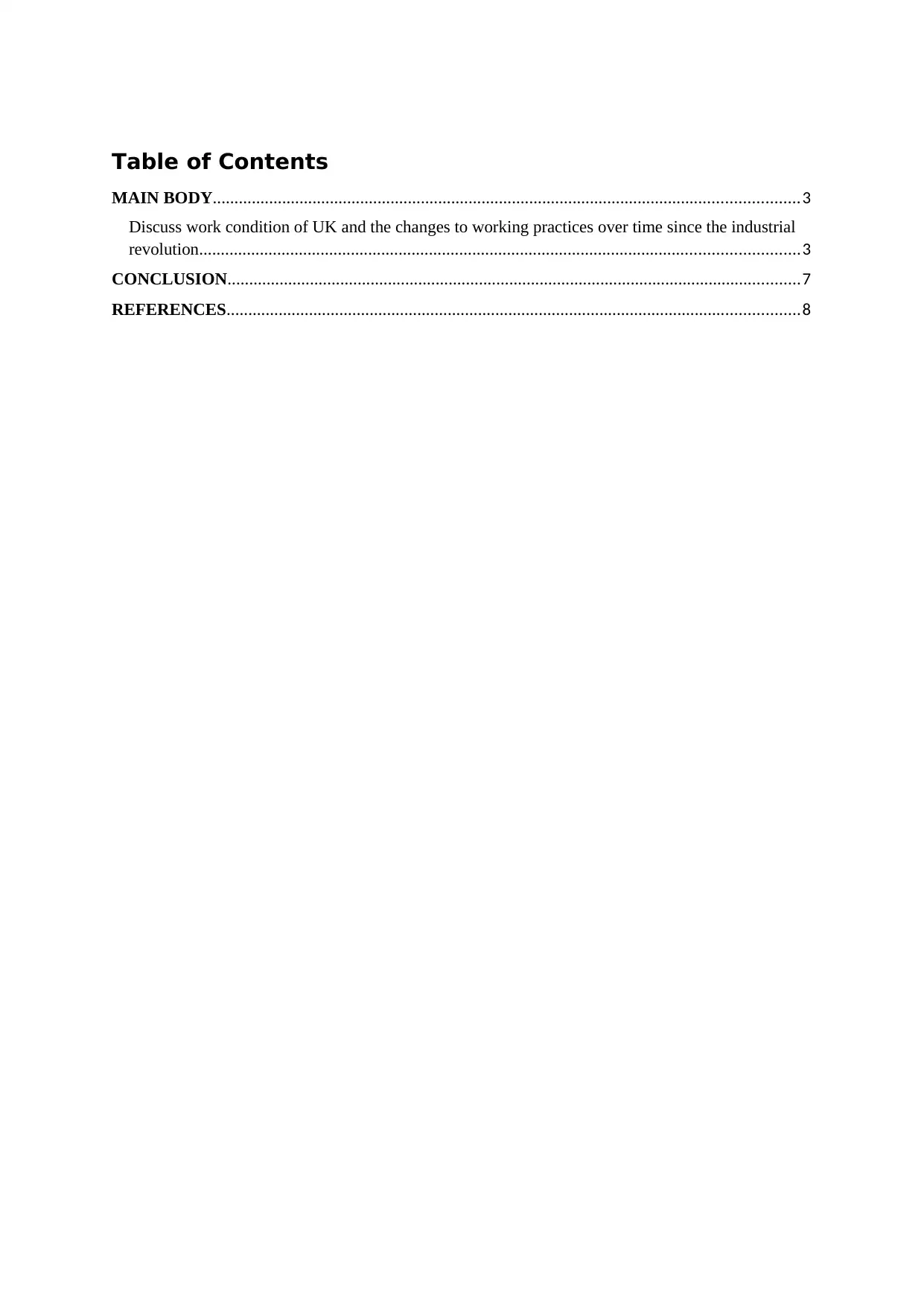
Table of Contents
MAIN BODY.......................................................................................................................................3
Discuss work condition of UK and the changes to working practices over time since the industrial
revolution..........................................................................................................................................3
CONCLUSION....................................................................................................................................7
REFERENCES....................................................................................................................................8
MAIN BODY.......................................................................................................................................3
Discuss work condition of UK and the changes to working practices over time since the industrial
revolution..........................................................................................................................................3
CONCLUSION....................................................................................................................................7
REFERENCES....................................................................................................................................8
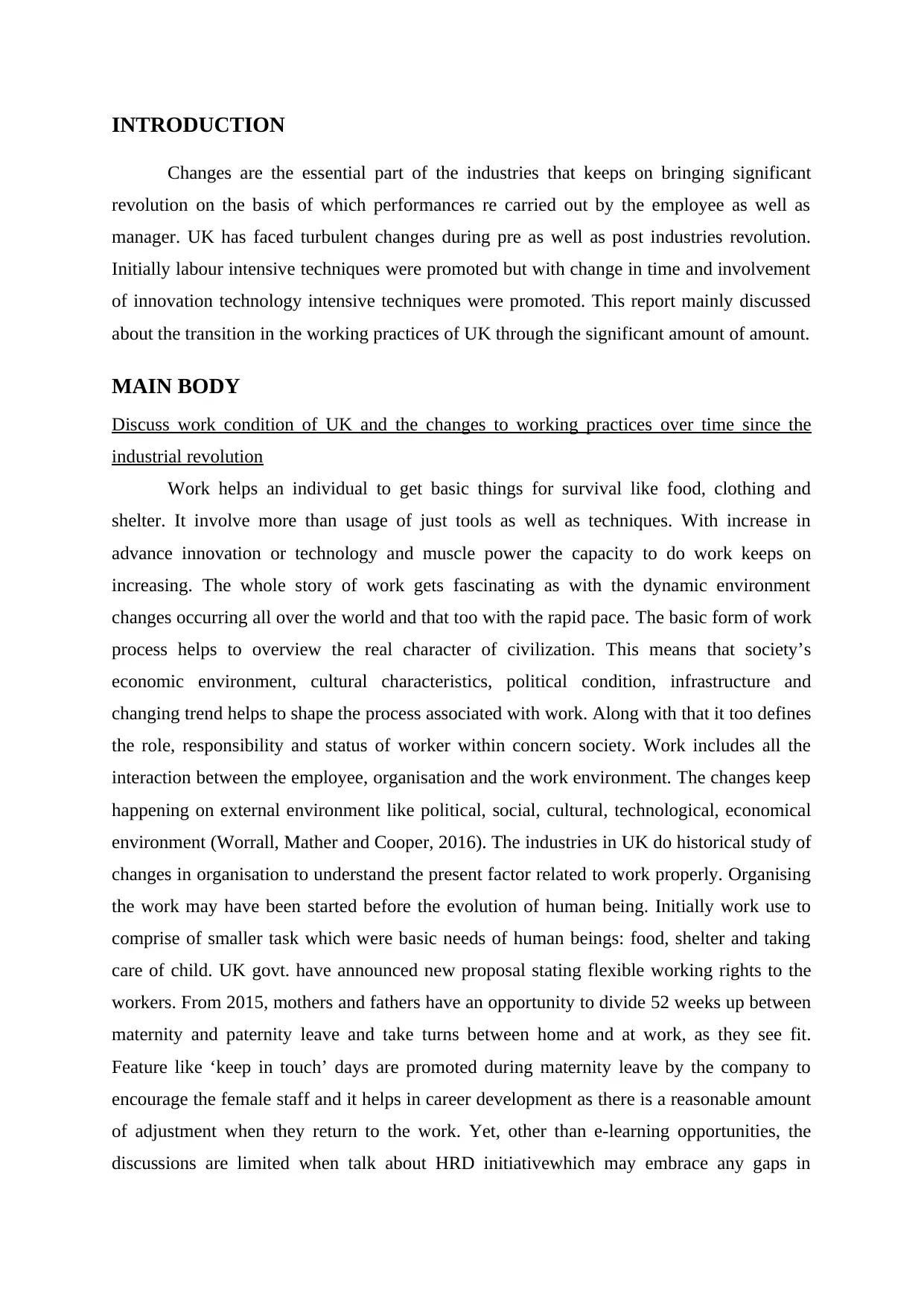
INTRODUCTION
Changes are the essential part of the industries that keeps on bringing significant
revolution on the basis of which performances re carried out by the employee as well as
manager. UK has faced turbulent changes during pre as well as post industries revolution.
Initially labour intensive techniques were promoted but with change in time and involvement
of innovation technology intensive techniques were promoted. This report mainly discussed
about the transition in the working practices of UK through the significant amount of amount.
MAIN BODY
Discuss work condition of UK and the changes to working practices over time since the
industrial revolution
Work helps an individual to get basic things for survival like food, clothing and
shelter. It involve more than usage of just tools as well as techniques. With increase in
advance innovation or technology and muscle power the capacity to do work keeps on
increasing. The whole story of work gets fascinating as with the dynamic environment
changes occurring all over the world and that too with the rapid pace. The basic form of work
process helps to overview the real character of civilization. This means that society’s
economic environment, cultural characteristics, political condition, infrastructure and
changing trend helps to shape the process associated with work. Along with that it too defines
the role, responsibility and status of worker within concern society. Work includes all the
interaction between the employee, organisation and the work environment. The changes keep
happening on external environment like political, social, cultural, technological, economical
environment (Worrall, Mather and Cooper, 2016). The industries in UK do historical study of
changes in organisation to understand the present factor related to work properly. Organising
the work may have been started before the evolution of human being. Initially work use to
comprise of smaller task which were basic needs of human beings: food, shelter and taking
care of child. UK govt. have announced new proposal stating flexible working rights to the
workers. From 2015, mothers and fathers have an opportunity to divide 52 weeks up between
maternity and paternity leave and take turns between home and at work, as they see fit.
Feature like ‘keep in touch’ days are promoted during maternity leave by the company to
encourage the female staff and it helps in career development as there is a reasonable amount
of adjustment when they return to the work. Yet, other than e-learning opportunities, the
discussions are limited when talk about HRD initiativewhich may embrace any gaps in
Changes are the essential part of the industries that keeps on bringing significant
revolution on the basis of which performances re carried out by the employee as well as
manager. UK has faced turbulent changes during pre as well as post industries revolution.
Initially labour intensive techniques were promoted but with change in time and involvement
of innovation technology intensive techniques were promoted. This report mainly discussed
about the transition in the working practices of UK through the significant amount of amount.
MAIN BODY
Discuss work condition of UK and the changes to working practices over time since the
industrial revolution
Work helps an individual to get basic things for survival like food, clothing and
shelter. It involve more than usage of just tools as well as techniques. With increase in
advance innovation or technology and muscle power the capacity to do work keeps on
increasing. The whole story of work gets fascinating as with the dynamic environment
changes occurring all over the world and that too with the rapid pace. The basic form of work
process helps to overview the real character of civilization. This means that society’s
economic environment, cultural characteristics, political condition, infrastructure and
changing trend helps to shape the process associated with work. Along with that it too defines
the role, responsibility and status of worker within concern society. Work includes all the
interaction between the employee, organisation and the work environment. The changes keep
happening on external environment like political, social, cultural, technological, economical
environment (Worrall, Mather and Cooper, 2016). The industries in UK do historical study of
changes in organisation to understand the present factor related to work properly. Organising
the work may have been started before the evolution of human being. Initially work use to
comprise of smaller task which were basic needs of human beings: food, shelter and taking
care of child. UK govt. have announced new proposal stating flexible working rights to the
workers. From 2015, mothers and fathers have an opportunity to divide 52 weeks up between
maternity and paternity leave and take turns between home and at work, as they see fit.
Feature like ‘keep in touch’ days are promoted during maternity leave by the company to
encourage the female staff and it helps in career development as there is a reasonable amount
of adjustment when they return to the work. Yet, other than e-learning opportunities, the
discussions are limited when talk about HRD initiativewhich may embrace any gaps in
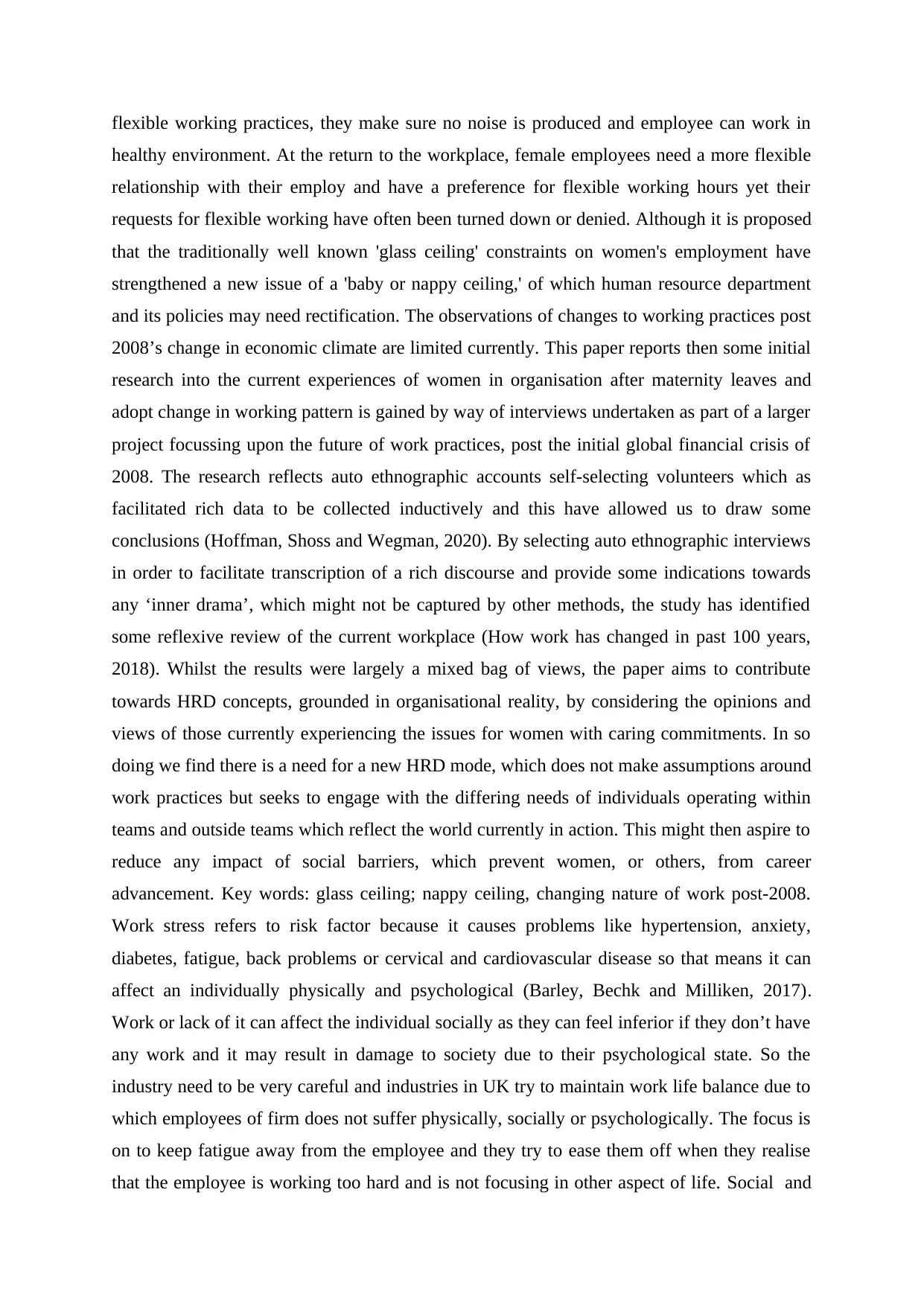
flexible working practices, they make sure no noise is produced and employee can work in
healthy environment. At the return to the workplace, female employees need a more flexible
relationship with their employ and have a preference for flexible working hours yet their
requests for flexible working have often been turned down or denied. Although it is proposed
that the traditionally well known 'glass ceiling' constraints on women's employment have
strengthened a new issue of a 'baby or nappy ceiling,' of which human resource department
and its policies may need rectification. The observations of changes to working practices post
2008’s change in economic climate are limited currently. This paper reports then some initial
research into the current experiences of women in organisation after maternity leaves and
adopt change in working pattern is gained by way of interviews undertaken as part of a larger
project focussing upon the future of work practices, post the initial global financial crisis of
2008. The research reflects auto ethnographic accounts self-selecting volunteers which as
facilitated rich data to be collected inductively and this have allowed us to draw some
conclusions (Hoffman, Shoss and Wegman, 2020). By selecting auto ethnographic interviews
in order to facilitate transcription of a rich discourse and provide some indications towards
any ‘inner drama’, which might not be captured by other methods, the study has identified
some reflexive review of the current workplace (How work has changed in past 100 years,
2018). Whilst the results were largely a mixed bag of views, the paper aims to contribute
towards HRD concepts, grounded in organisational reality, by considering the opinions and
views of those currently experiencing the issues for women with caring commitments. In so
doing we find there is a need for a new HRD mode, which does not make assumptions around
work practices but seeks to engage with the differing needs of individuals operating within
teams and outside teams which reflect the world currently in action. This might then aspire to
reduce any impact of social barriers, which prevent women, or others, from career
advancement. Key words: glass ceiling; nappy ceiling, changing nature of work post-2008.
Work stress refers to risk factor because it causes problems like hypertension, anxiety,
diabetes, fatigue, back problems or cervical and cardiovascular disease so that means it can
affect an individually physically and psychological (Barley, Bechk and Milliken, 2017).
Work or lack of it can affect the individual socially as they can feel inferior if they don’t have
any work and it may result in damage to society due to their psychological state. So the
industry need to be very careful and industries in UK try to maintain work life balance due to
which employees of firm does not suffer physically, socially or psychologically. The focus is
on to keep fatigue away from the employee and they try to ease them off when they realise
that the employee is working too hard and is not focusing in other aspect of life. Social and
healthy environment. At the return to the workplace, female employees need a more flexible
relationship with their employ and have a preference for flexible working hours yet their
requests for flexible working have often been turned down or denied. Although it is proposed
that the traditionally well known 'glass ceiling' constraints on women's employment have
strengthened a new issue of a 'baby or nappy ceiling,' of which human resource department
and its policies may need rectification. The observations of changes to working practices post
2008’s change in economic climate are limited currently. This paper reports then some initial
research into the current experiences of women in organisation after maternity leaves and
adopt change in working pattern is gained by way of interviews undertaken as part of a larger
project focussing upon the future of work practices, post the initial global financial crisis of
2008. The research reflects auto ethnographic accounts self-selecting volunteers which as
facilitated rich data to be collected inductively and this have allowed us to draw some
conclusions (Hoffman, Shoss and Wegman, 2020). By selecting auto ethnographic interviews
in order to facilitate transcription of a rich discourse and provide some indications towards
any ‘inner drama’, which might not be captured by other methods, the study has identified
some reflexive review of the current workplace (How work has changed in past 100 years,
2018). Whilst the results were largely a mixed bag of views, the paper aims to contribute
towards HRD concepts, grounded in organisational reality, by considering the opinions and
views of those currently experiencing the issues for women with caring commitments. In so
doing we find there is a need for a new HRD mode, which does not make assumptions around
work practices but seeks to engage with the differing needs of individuals operating within
teams and outside teams which reflect the world currently in action. This might then aspire to
reduce any impact of social barriers, which prevent women, or others, from career
advancement. Key words: glass ceiling; nappy ceiling, changing nature of work post-2008.
Work stress refers to risk factor because it causes problems like hypertension, anxiety,
diabetes, fatigue, back problems or cervical and cardiovascular disease so that means it can
affect an individually physically and psychological (Barley, Bechk and Milliken, 2017).
Work or lack of it can affect the individual socially as they can feel inferior if they don’t have
any work and it may result in damage to society due to their psychological state. So the
industry need to be very careful and industries in UK try to maintain work life balance due to
which employees of firm does not suffer physically, socially or psychologically. The focus is
on to keep fatigue away from the employee and they try to ease them off when they realise
that the employee is working too hard and is not focusing in other aspect of life. Social and
Secure Best Marks with AI Grader
Need help grading? Try our AI Grader for instant feedback on your assignments.
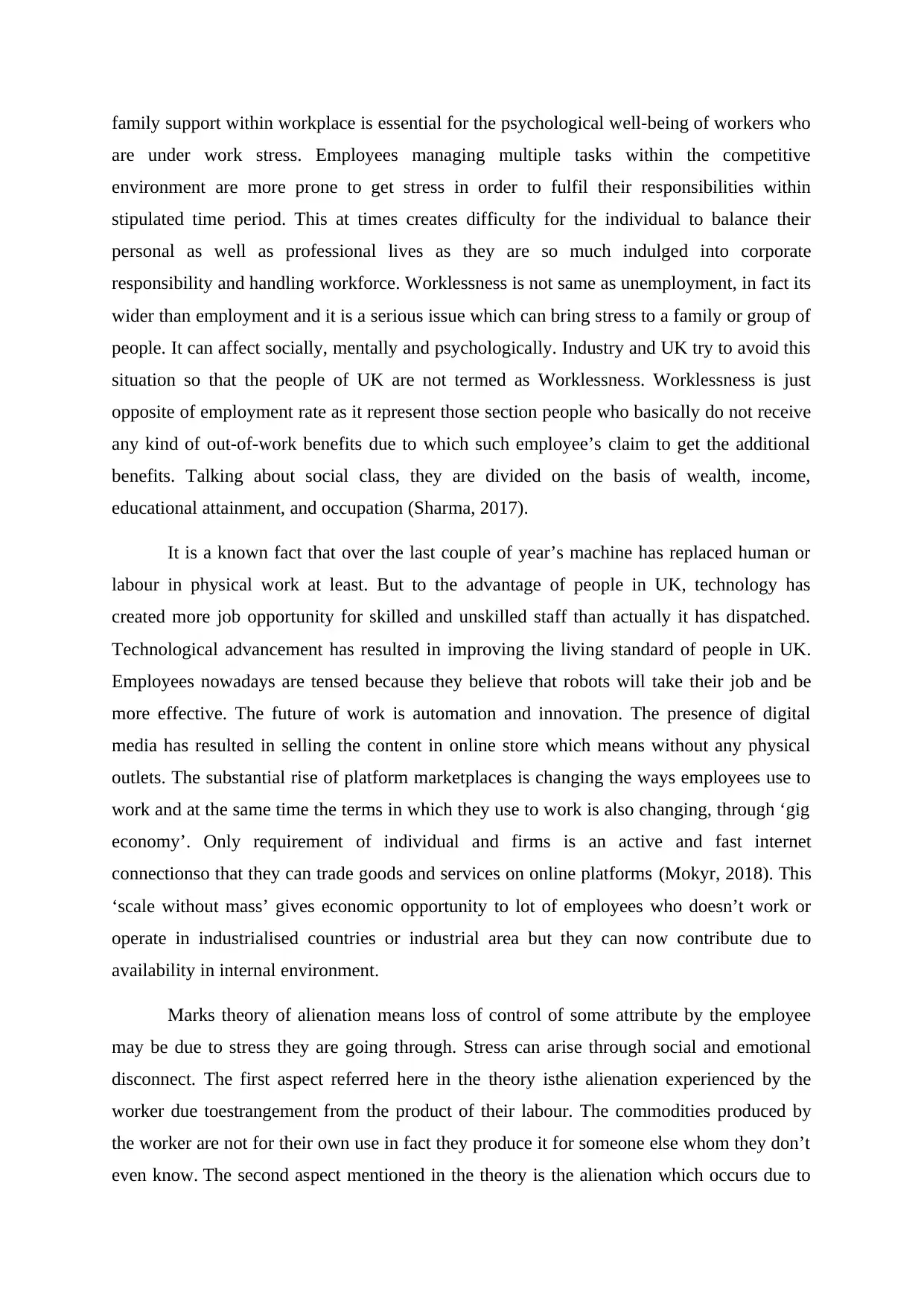
family support within workplace is essential for the psychological well-being of workers who
are under work stress. Employees managing multiple tasks within the competitive
environment are more prone to get stress in order to fulfil their responsibilities within
stipulated time period. This at times creates difficulty for the individual to balance their
personal as well as professional lives as they are so much indulged into corporate
responsibility and handling workforce. Worklessness is not same as unemployment, in fact its
wider than employment and it is a serious issue which can bring stress to a family or group of
people. It can affect socially, mentally and psychologically. Industry and UK try to avoid this
situation so that the people of UK are not termed as Worklessness. Worklessness is just
opposite of employment rate as it represent those section people who basically do not receive
any kind of out-of-work benefits due to which such employee’s claim to get the additional
benefits. Talking about social class, they are divided on the basis of wealth, income,
educational attainment, and occupation (Sharma, 2017).
It is a known fact that over the last couple of year’s machine has replaced human or
labour in physical work at least. But to the advantage of people in UK, technology has
created more job opportunity for skilled and unskilled staff than actually it has dispatched.
Technological advancement has resulted in improving the living standard of people in UK.
Employees nowadays are tensed because they believe that robots will take their job and be
more effective. The future of work is automation and innovation. The presence of digital
media has resulted in selling the content in online store which means without any physical
outlets. The substantial rise of platform marketplaces is changing the ways employees use to
work and at the same time the terms in which they use to work is also changing, through ‘gig
economy’. Only requirement of individual and firms is an active and fast internet
connectionso that they can trade goods and services on online platforms (Mokyr, 2018). This
‘scale without mass’ gives economic opportunity to lot of employees who doesn’t work or
operate in industrialised countries or industrial area but they can now contribute due to
availability in internal environment.
Marks theory of alienation means loss of control of some attribute by the employee
may be due to stress they are going through. Stress can arise through social and emotional
disconnect. The first aspect referred here in the theory isthe alienation experienced by the
worker due toestrangement from the product of their labour. The commodities produced by
the worker are not for their own use in fact they produce it for someone else whom they don’t
even know. The second aspect mentioned in the theory is the alienation which occurs due to
are under work stress. Employees managing multiple tasks within the competitive
environment are more prone to get stress in order to fulfil their responsibilities within
stipulated time period. This at times creates difficulty for the individual to balance their
personal as well as professional lives as they are so much indulged into corporate
responsibility and handling workforce. Worklessness is not same as unemployment, in fact its
wider than employment and it is a serious issue which can bring stress to a family or group of
people. It can affect socially, mentally and psychologically. Industry and UK try to avoid this
situation so that the people of UK are not termed as Worklessness. Worklessness is just
opposite of employment rate as it represent those section people who basically do not receive
any kind of out-of-work benefits due to which such employee’s claim to get the additional
benefits. Talking about social class, they are divided on the basis of wealth, income,
educational attainment, and occupation (Sharma, 2017).
It is a known fact that over the last couple of year’s machine has replaced human or
labour in physical work at least. But to the advantage of people in UK, technology has
created more job opportunity for skilled and unskilled staff than actually it has dispatched.
Technological advancement has resulted in improving the living standard of people in UK.
Employees nowadays are tensed because they believe that robots will take their job and be
more effective. The future of work is automation and innovation. The presence of digital
media has resulted in selling the content in online store which means without any physical
outlets. The substantial rise of platform marketplaces is changing the ways employees use to
work and at the same time the terms in which they use to work is also changing, through ‘gig
economy’. Only requirement of individual and firms is an active and fast internet
connectionso that they can trade goods and services on online platforms (Mokyr, 2018). This
‘scale without mass’ gives economic opportunity to lot of employees who doesn’t work or
operate in industrialised countries or industrial area but they can now contribute due to
availability in internal environment.
Marks theory of alienation means loss of control of some attribute by the employee
may be due to stress they are going through. Stress can arise through social and emotional
disconnect. The first aspect referred here in the theory isthe alienation experienced by the
worker due toestrangement from the product of their labour. The commodities produced by
the worker are not for their own use in fact they produce it for someone else whom they don’t
even know. The second aspect mentioned in the theory is the alienation which occurs due to
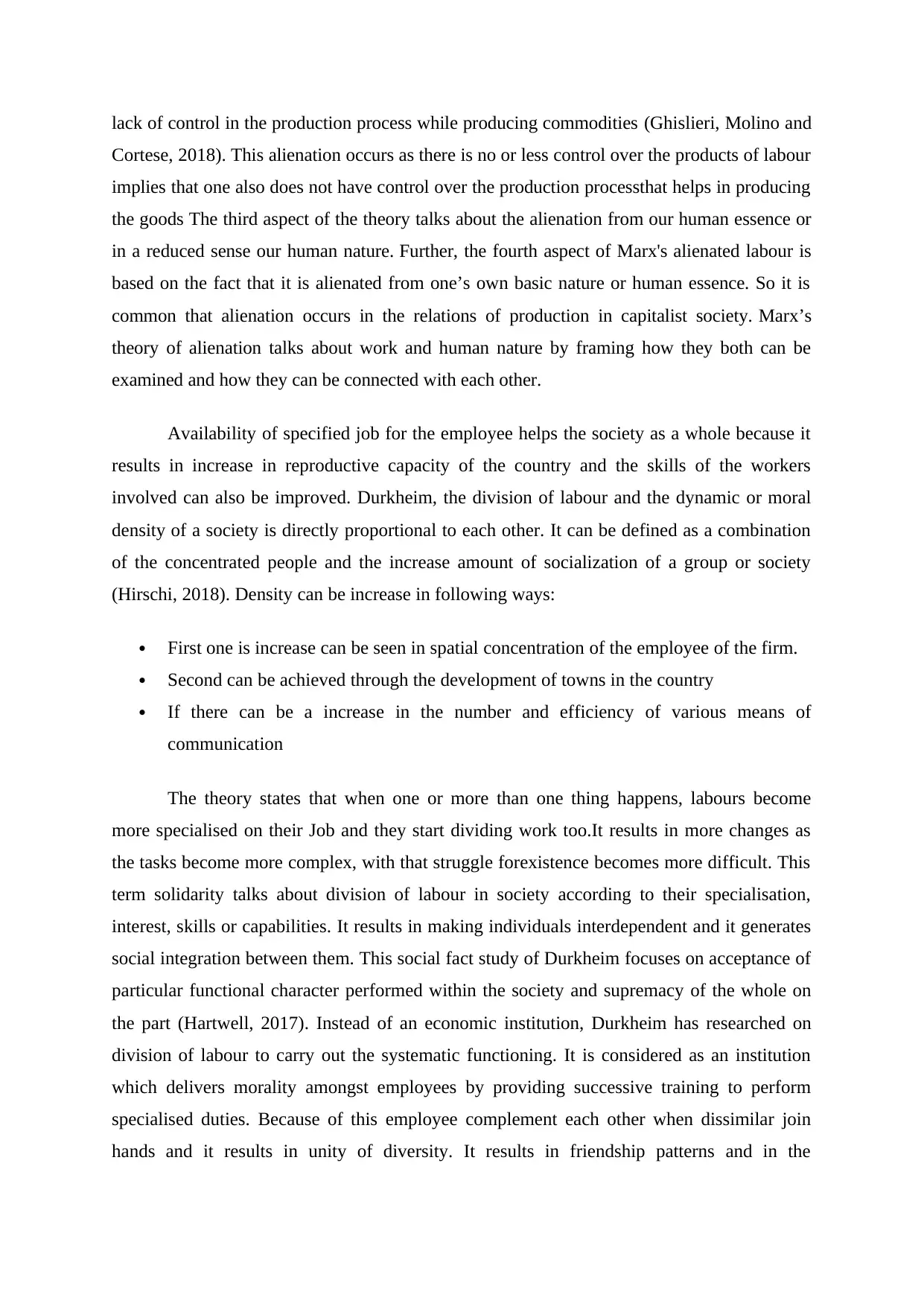
lack of control in the production process while producing commodities (Ghislieri, Molino and
Cortese, 2018). This alienation occurs as there is no or less control over the products of labour
implies that one also does not have control over the production processthat helps in producing
the goods The third aspect of the theory talks about the alienation from our human essence or
in a reduced sense our human nature. Further, the fourth aspect of Marx's alienated labour is
based on the fact that it is alienated from one’s own basic nature or human essence. So it is
common that alienation occurs in the relations of production in capitalist society. Marx’s
theory of alienation talks about work and human nature by framing how they both can be
examined and how they can be connected with each other.
Availability of specified job for the employee helps the society as a whole because it
results in increase in reproductive capacity of the country and the skills of the workers
involved can also be improved. Durkheim, the division of labour and the dynamic or moral
density of a society is directly proportional to each other. It can be defined as a combination
of the concentrated people and the increase amount of socialization of a group or society
(Hirschi, 2018). Density can be increase in following ways:
First one is increase can be seen in spatial concentration of the employee of the firm.
Second can be achieved through the development of towns in the country
If there can be a increase in the number and efficiency of various means of
communication
The theory states that when one or more than one thing happens, labours become
more specialised on their Job and they start dividing work too.It results in more changes as
the tasks become more complex, with that struggle forexistence becomes more difficult. This
term solidarity talks about division of labour in society according to their specialisation,
interest, skills or capabilities. It results in making individuals interdependent and it generates
social integration between them. This social fact study of Durkheim focuses on acceptance of
particular functional character performed within the society and supremacy of the whole on
the part (Hartwell, 2017). Instead of an economic institution, Durkheim has researched on
division of labour to carry out the systematic functioning. It is considered as an institution
which delivers morality amongst employees by providing successive training to perform
specialised duties. Because of this employee complement each other when dissimilar join
hands and it results in unity of diversity. It results in friendship patterns and in the
Cortese, 2018). This alienation occurs as there is no or less control over the products of labour
implies that one also does not have control over the production processthat helps in producing
the goods The third aspect of the theory talks about the alienation from our human essence or
in a reduced sense our human nature. Further, the fourth aspect of Marx's alienated labour is
based on the fact that it is alienated from one’s own basic nature or human essence. So it is
common that alienation occurs in the relations of production in capitalist society. Marx’s
theory of alienation talks about work and human nature by framing how they both can be
examined and how they can be connected with each other.
Availability of specified job for the employee helps the society as a whole because it
results in increase in reproductive capacity of the country and the skills of the workers
involved can also be improved. Durkheim, the division of labour and the dynamic or moral
density of a society is directly proportional to each other. It can be defined as a combination
of the concentrated people and the increase amount of socialization of a group or society
(Hirschi, 2018). Density can be increase in following ways:
First one is increase can be seen in spatial concentration of the employee of the firm.
Second can be achieved through the development of towns in the country
If there can be a increase in the number and efficiency of various means of
communication
The theory states that when one or more than one thing happens, labours become
more specialised on their Job and they start dividing work too.It results in more changes as
the tasks become more complex, with that struggle forexistence becomes more difficult. This
term solidarity talks about division of labour in society according to their specialisation,
interest, skills or capabilities. It results in making individuals interdependent and it generates
social integration between them. This social fact study of Durkheim focuses on acceptance of
particular functional character performed within the society and supremacy of the whole on
the part (Hartwell, 2017). Instead of an economic institution, Durkheim has researched on
division of labour to carry out the systematic functioning. It is considered as an institution
which delivers morality amongst employees by providing successive training to perform
specialised duties. Because of this employee complement each other when dissimilar join
hands and it results in unity of diversity. It results in friendship patterns and in the
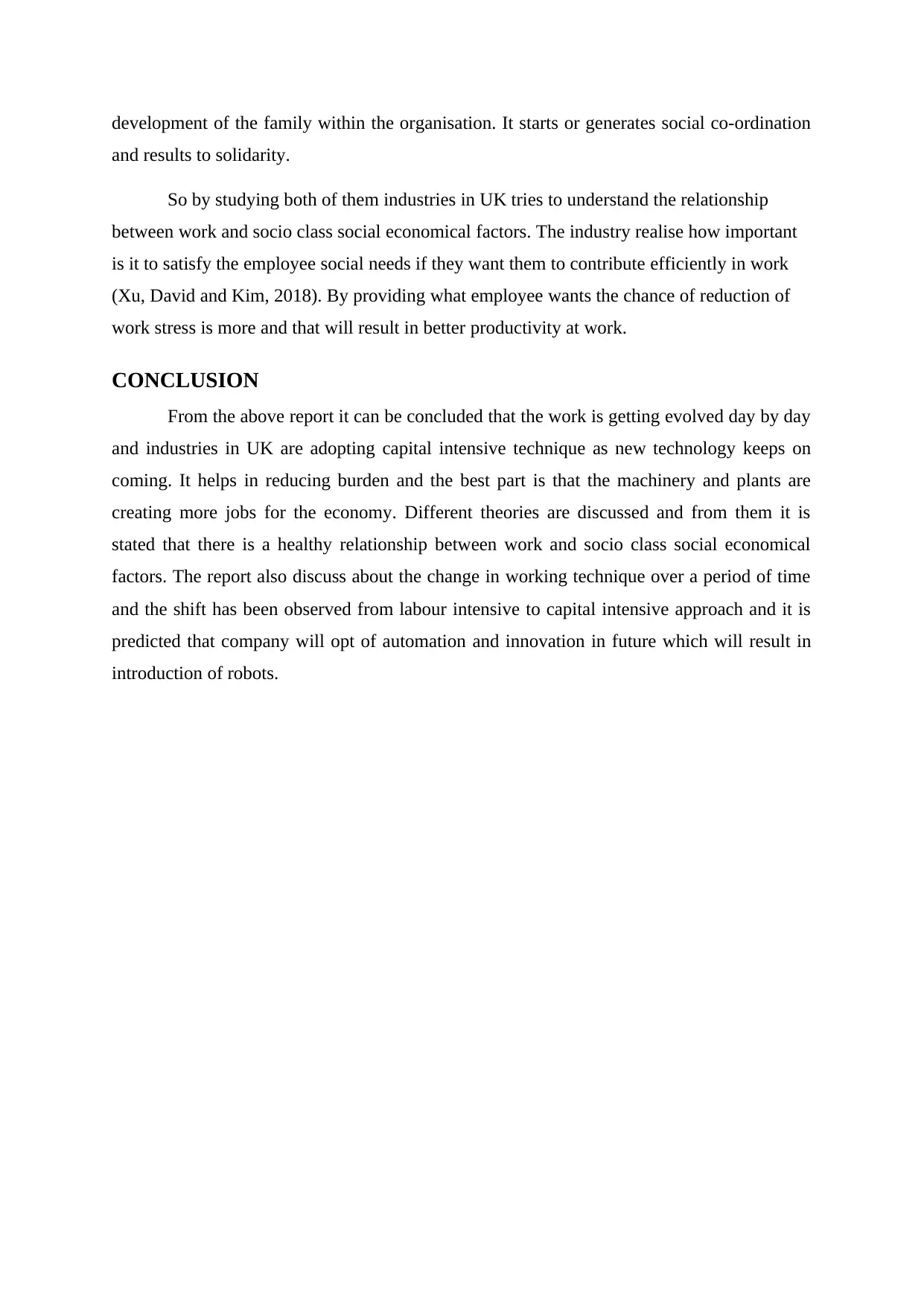
development of the family within the organisation. It starts or generates social co-ordination
and results to solidarity.
So by studying both of them industries in UK tries to understand the relationship
between work and socio class social economical factors. The industry realise how important
is it to satisfy the employee social needs if they want them to contribute efficiently in work
(Xu, David and Kim, 2018). By providing what employee wants the chance of reduction of
work stress is more and that will result in better productivity at work.
CONCLUSION
From the above report it can be concluded that the work is getting evolved day by day
and industries in UK are adopting capital intensive technique as new technology keeps on
coming. It helps in reducing burden and the best part is that the machinery and plants are
creating more jobs for the economy. Different theories are discussed and from them it is
stated that there is a healthy relationship between work and socio class social economical
factors. The report also discuss about the change in working technique over a period of time
and the shift has been observed from labour intensive to capital intensive approach and it is
predicted that company will opt of automation and innovation in future which will result in
introduction of robots.
and results to solidarity.
So by studying both of them industries in UK tries to understand the relationship
between work and socio class social economical factors. The industry realise how important
is it to satisfy the employee social needs if they want them to contribute efficiently in work
(Xu, David and Kim, 2018). By providing what employee wants the chance of reduction of
work stress is more and that will result in better productivity at work.
CONCLUSION
From the above report it can be concluded that the work is getting evolved day by day
and industries in UK are adopting capital intensive technique as new technology keeps on
coming. It helps in reducing burden and the best part is that the machinery and plants are
creating more jobs for the economy. Different theories are discussed and from them it is
stated that there is a healthy relationship between work and socio class social economical
factors. The report also discuss about the change in working technique over a period of time
and the shift has been observed from labour intensive to capital intensive approach and it is
predicted that company will opt of automation and innovation in future which will result in
introduction of robots.
Paraphrase This Document
Need a fresh take? Get an instant paraphrase of this document with our AI Paraphraser
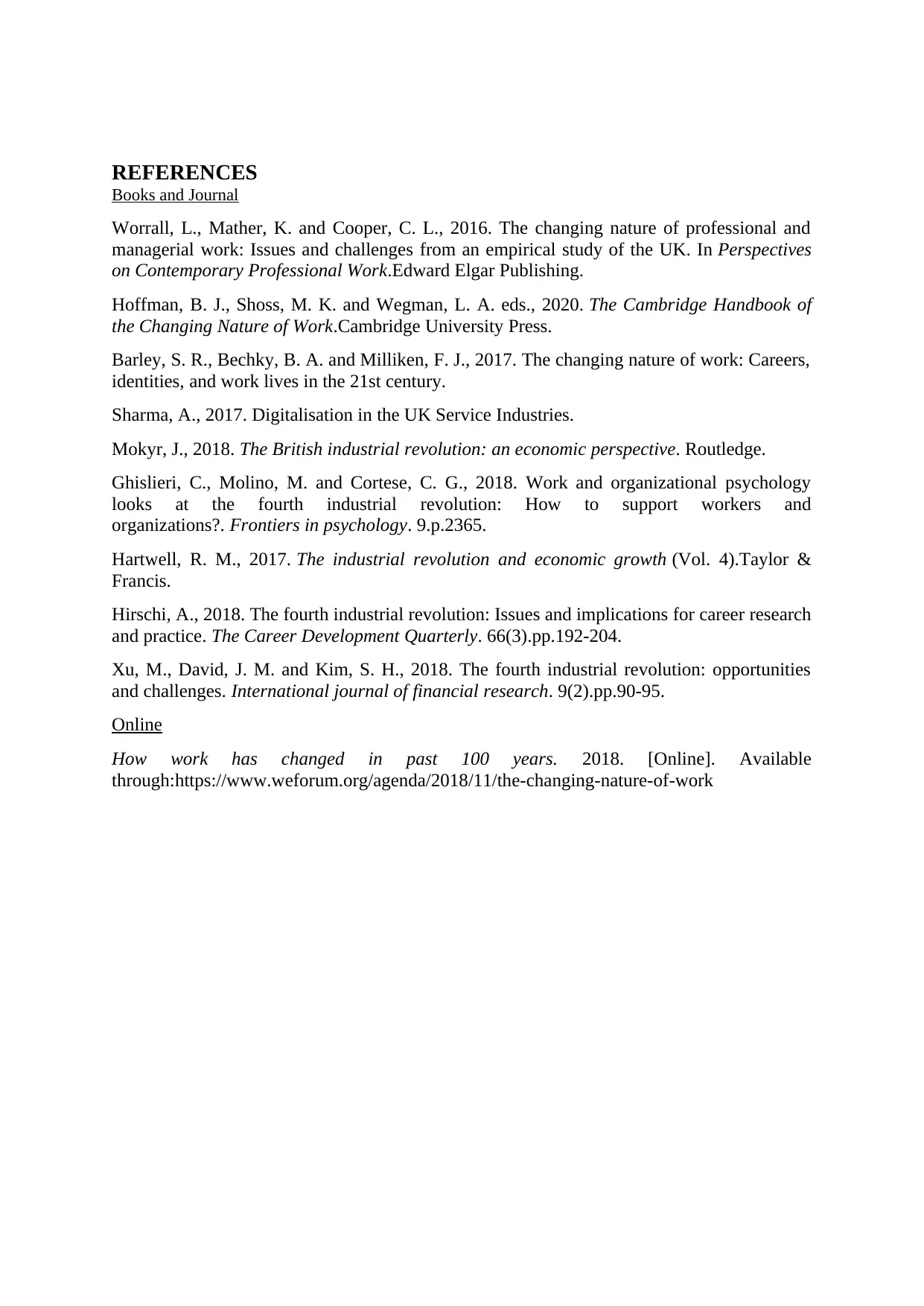
REFERENCES
Books and Journal
Worrall, L., Mather, K. and Cooper, C. L., 2016. The changing nature of professional and
managerial work: Issues and challenges from an empirical study of the UK. In Perspectives
on Contemporary Professional Work.Edward Elgar Publishing.
Hoffman, B. J., Shoss, M. K. and Wegman, L. A. eds., 2020. The Cambridge Handbook of
the Changing Nature of Work.Cambridge University Press.
Barley, S. R., Bechky, B. A. and Milliken, F. J., 2017. The changing nature of work: Careers,
identities, and work lives in the 21st century.
Sharma, A., 2017. Digitalisation in the UK Service Industries.
Mokyr, J., 2018. The British industrial revolution: an economic perspective. Routledge.
Ghislieri, C., Molino, M. and Cortese, C. G., 2018. Work and organizational psychology
looks at the fourth industrial revolution: How to support workers and
organizations?. Frontiers in psychology. 9.p.2365.
Hartwell, R. M., 2017. The industrial revolution and economic growth (Vol. 4).Taylor &
Francis.
Hirschi, A., 2018. The fourth industrial revolution: Issues and implications for career research
and practice. The Career Development Quarterly. 66(3).pp.192-204.
Xu, M., David, J. M. and Kim, S. H., 2018. The fourth industrial revolution: opportunities
and challenges. International journal of financial research. 9(2).pp.90-95.
Online
How work has changed in past 100 years. 2018. [Online]. Available
through:https://www.weforum.org/agenda/2018/11/the-changing-nature-of-work
Books and Journal
Worrall, L., Mather, K. and Cooper, C. L., 2016. The changing nature of professional and
managerial work: Issues and challenges from an empirical study of the UK. In Perspectives
on Contemporary Professional Work.Edward Elgar Publishing.
Hoffman, B. J., Shoss, M. K. and Wegman, L. A. eds., 2020. The Cambridge Handbook of
the Changing Nature of Work.Cambridge University Press.
Barley, S. R., Bechky, B. A. and Milliken, F. J., 2017. The changing nature of work: Careers,
identities, and work lives in the 21st century.
Sharma, A., 2017. Digitalisation in the UK Service Industries.
Mokyr, J., 2018. The British industrial revolution: an economic perspective. Routledge.
Ghislieri, C., Molino, M. and Cortese, C. G., 2018. Work and organizational psychology
looks at the fourth industrial revolution: How to support workers and
organizations?. Frontiers in psychology. 9.p.2365.
Hartwell, R. M., 2017. The industrial revolution and economic growth (Vol. 4).Taylor &
Francis.
Hirschi, A., 2018. The fourth industrial revolution: Issues and implications for career research
and practice. The Career Development Quarterly. 66(3).pp.192-204.
Xu, M., David, J. M. and Kim, S. H., 2018. The fourth industrial revolution: opportunities
and challenges. International journal of financial research. 9(2).pp.90-95.
Online
How work has changed in past 100 years. 2018. [Online]. Available
through:https://www.weforum.org/agenda/2018/11/the-changing-nature-of-work
1 out of 8
Related Documents
Your All-in-One AI-Powered Toolkit for Academic Success.
+13062052269
info@desklib.com
Available 24*7 on WhatsApp / Email
![[object Object]](/_next/static/media/star-bottom.7253800d.svg)
Unlock your academic potential
© 2024 | Zucol Services PVT LTD | All rights reserved.




